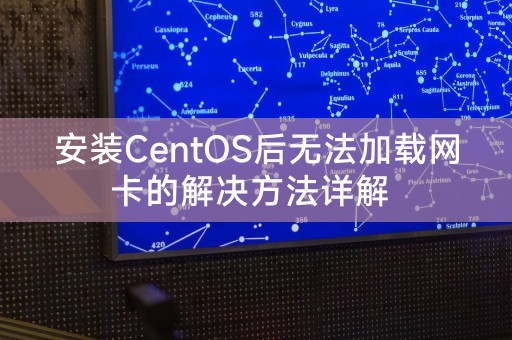Home >System Tutorial >LINUX >Detailed explanation of the solution to the problem that the network card cannot be loaded after installing CentOS
Detailed explanation of the solution to the problem that the network card cannot be loaded after installing CentOS
- WBOYWBOYWBOYWBOYWBOYWBOYWBOYWBOYWBOYWBOYWBOYWBOYWBforward
- 2024-02-10 12:57:201186browse
php editor Yuzai brings you a detailed solution to the problem that the network card cannot be loaded after CentOS installation. After installing the CentOS operating system, sometimes the network card cannot be loaded, which brings troubles to the network connection. In this article, we will explain what may be causing this problem and provide a series of simple and effective solutions to help you solve this problem and restore normal network connectivity. Whether you are a beginner or an experienced user, this article will provide you with easy-to-understand and implement guidance to quickly resolve network card loading issues.

After installing CentOS, when we open the terminal and enter the "ifconfig" command, we may find that no network card information is displayed, or only lo (loopback interface) information is displayed , which means that the system did not successfully load the network card driver, resulting in the inability to connect to the network.
The following are some possible solutions that you can try based on your specific situation.
Make sure your network card is correctly connected to the computer's network card slot and the connection is stable. If you are using an external network card, make sure it is correctly connected to the computer's USB interface.
In some cases, the network card may be disabled or set to "Auto" mode. When the computer starts, press the corresponding key (usually F2, F10 or Delete) to enter the BIOS setup interface, and then find "Integrated Peripherals" or similar option, make sure the network card is enabled or set to "Auto".
If your network card is newly purchased or a newer model, you may need to download and install the latest network card driver. You can find the applicable support page by visiting the official website of the network card manufacturer. Download the latest driver for CentOS and follow the instructions to install it.
Open the terminal and enter the "lspci" command to view the network card information recognized by the system. If you can see the network card information, it means that the system has correctly identified the network card. You can try to use the modprobe command to load the network card driver, for example "modprobe e1000".
Older versions of CentOS may not support some new models of network cards. You can try to solve this problem by updating the kernel. Use the "uname -r" command to view the currently installed kernel version, and then visit the CentOS official website. Download and install the latest kernel version.
The network configuration file may be wrong or missing. You can use an editor to open the network configuration file in the "/etc/sysconfig/network-scripts/" directory (usually starting with "ifcfg-") and check Check whether the configuration is correct and make necessary modifications.
After completing the above operations, you can try to restart the network service to make the changes take effect. Use the following command to restart the network service:
```
service network restart
In the LINUX system, you can use the "ifconfig" command to view and configure the network interface information, and you can use the "ifconfig eth0 up" command to enable the network card interface named eth0. This is a simple and practical LINUX knowledge. .
The above is the detailed content of Detailed explanation of the solution to the problem that the network card cannot be loaded after installing CentOS. For more information, please follow other related articles on the PHP Chinese website!

